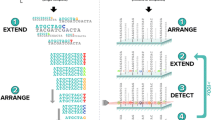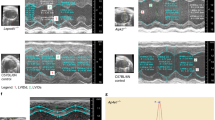Abstract
Non-syndromic hearing impairment (NSHI) is the most common form of deafness and presents with no other symptoms or sensory defects. Mutations in the gap junction gene GJB2 account for a high proportion of recessive NSHI. The GJB2 gene encodes connexin 26, which forms plasma membrane channels between cochlear cells. In Caucasian populations a single mutation, 35delG, accounts for most cases of NSHI. This mutation appears to be most prevalent in individuals of Mediterranean European descent, with carrier frequencies estimated as being as high as one in thirty. The 35delG region may be a mutational hotspot. The mutation arises from the deletion of a guanine from a six-guanine stretch and nearby microsatellite markers show little evidence for linkage disequilibrium. We believe that 35delG is an old mutation in a chromosomal region of high recombination. The genetic context of the 35delG mutation was examined to distinguish between an old or a recurring mutation. We identified two single-nucleotide polymorphisms (SNPs) immediately upstream of the first exon of GJB2. Polymerase chain reaction/restriction fragment length polymorphism analysis determined the SNP genotype of 35delG containing chromosomes from various populations, including Italy, Brazil, and North America. We found the same, relatively rare, polymorphism associated with the 35delG mutation in all populations studied. We have also examined microsatellite markers D13S175, which is 80 kb telomeric to GJB2, and D13S1316, which is 80 kb centromeric to GJB2. D13S175 appears to be in weak linkage disequilibrium with 35delG, while D13S1316 is less so. SNPs located between the 35delG mutation and the microsatellite markers show strong evidence of linkage disequilibrium. Taken together, these results indicate there has been substantial recombination near the 35delG mutation; however, we present evidence that the 35delG mutation arose in European and Middle Eastern populations from a single mutational event on a founder chromosome.


Similar content being viewed by others
References
Abe S, Usami S-I, Shinkawa H, Kelley PM, Kimberling WJ (2000) Prevalent connexin 26 gene (GJB2) mutations in Japanese. J Med Genet 37:41–43
Carrasquillo MM, Zlotogora J, Barges S, Chakravarti A (1997) Two different connexin 26 mutations in an inbred kindred segregating non-syndromic recessive deafness: implications for genetic studies in isolated populations. Hum Mol Genet 6:2163–2172
Cohn ES, Kelley PM (1999) Clinical phenotype and mutations in connexin 26 (DFNB1/GJB2), the most common cause of childhood hearing loss. Am J Med Genet 89:130–136
Denoyelle F, Weil D, Maw MA, Wilcox SA, Lench NJ, Allen-Powell DR, Osborn AH, Dahl H-HM, Middleton A, Houseman MJ, Dode C, Marlin S, Boulila-ElGaied A, Grati M, Ayadi H, BenArab S, Bitoun P, Lina-Granade G, Godet J, Mustapha M, Loiselet J, El-Zir E, Aubois A, Joannard A, Levilliers J, Garabedian E-N, Mueller RF, Gardner RJM, Petit C (1997) Prelingual deafness: high prevalence of a 30delG mutation in the connexin 26 gene. Hum Mol Genet 6:2173–2177
Estivill X, Fortina P, Surrey S, Rabionet R, Melchionda S, D'Agruma L, Mansfield E, Rappaport E, Govea N, Mila M, Zelante L, Gasparini P (1998) Connexin-26 mutations in sporadic and inherited sensorineural deafness Lancet 351:394–398
Fuse Y, Doi K, Hasegawa T, Sugii A, Hibina H, Kubo T (1999) Three novel connexin26 gene mutations in autosomal recessive non-syndromic deafness Neuroreport 10:1853–1857
Gasparini P, Rabionet R, Barbujani G, Melchionda S, Petersen M, Brondum-Nielsen K, Metspalu A, Oitmaa E, Pisano M, Fortina P, Zelante L, Estivill X (2000) High carrier frequency of the 35delG deafness mutation in European populations. Genetic Analysis Consortium of GJB2 35delG. Eur J Hum Genet 8:19–23
Green GE, Scott DA, McDonald JM, Woodworth GG, Sheffield VC, Smith RJH (1999) Carrier rates in the Midwestern United States for GJB2 mutations causing inherited deafness JAMA 281:2211–2216
Hamelmann C, Amedofu GK, Albrecht K, Muntau B, Gelhaus A, Brobby GW, Horstmann RD (2001) Pattern of connexin 26 (GJB2) mutations causing sensorineural hearing impairment in Ghana. Hum Mut 18:84–85
International Human Genome Sequencing Consortium (2001) Initial sequencing and analysis of the human genome. Nature 409:860–921
Kiang DT, Jin N, Tu ZJ, Lin HH (1997) Upstream genomic sequence of the human connexin26 gene. Gene 199:165–171
Kikuchi T, Kimura RS, Paul DL, Adams JC (1995) Gap junctions in the rat cochlea: immunohistochemical and ultrastructural analysis Anat Embryol 191:101–118
Krawczak M, Cooper DN (1991) Gene deletions causing human genetic disease: mechanisms of mutagenesis and the role of the local DNA sequence environment. Hum Genet 86:425–441
Kudo T, Ikeda K, Kure S, Matsubara Y, Oshima T, Watanabe K, Kawase T, Narisawa K, Takasaka T (2000) Novel mutations in the connexin 26 gene (GJB2) responsible for childhood deafness in the Japanese population. Am J Med Genet 90:141–145
Morell RJ, Kim HJ, Hood LJ, Goforth L, Friderici K, Fisher R, Van Camp G, Berlin CI, Oddoux C, Ostrer H, Keats B, Friedman TB (1998) Mutations in the connexin 26 gene (GJB2) among Ashkenazi Jews with nonsyndromic recessive deafness. N Engl JMed 339:1500–1505
Nance WE, Liu XZ, Pandya A (2000) Relation between choice of partner and high frequency of connexin-26 deafness Lancet 356:500–501
Shahin H, Walsh T, Sobe T, Lynch E, King M-C, Avraham KB, Kanaan M (2002) Genetics of congenital deafness in the Palestinian population: multiple connexin 26 alleles with shared origins in the Middle East. Hum Genet 110:284–289
Tekin M, Akar N, Cin S, Blanton SH, Xia XJ, Liu X-Z, Nance WE, Pandya A (2001) Connexin 26 (GJB2) mutations in the Turkish population: implications for the origin and high frequency of the 35delG mutation in Caucasians. Hum Genet 108:385–389
Van Laer L, Coucke P, Mueller RF, Caethoven G, Flothmann K, Prasad SD, Chamberlin GP, Houseman M, Taylor GR, Van de Heyning CM, Fransen E, Rowland J, Cucci RA, Smith RJH, Van Camp G (2001) A common founder for the 35delG GJB2 gene mutation in connexin 26 hearing impairment J Med Genet 38:515–518
Wilcox SA, Osborn AH, Dahl H-HM (2000) A simple PCR test to detect the common 35delG mutation in the connexin 26 gene Mol Diagn 5:75–78
Zelante L, Gasparini P, Estivill X, Melchionda S, D'Agruma L, Govea N, Mila M, Della Monica M, Lutfi J, Shohat M, Mansfield E, Delgrosso K, Rappaport E, Surrey S, Fortina P (1997) Connexin 26 mutations associated with the most common form of non-syndromic neurosensory autosomal recessive deafness (DFNB1) in Mediterraneans. Hum Mol Genet 6:1605–1609
Zhang J-T, Nicholson BJ (1989) Sequence and tissue distribution of a second protein of hepatic gap junctions, Cx26, as deduced from its cDNA. J Cell Biol 109:3391–3401
Acknowledgements
The authors thank Dr. Robert Morell, Laboratory of Molecular Genetics, NIDCD for patient DNA samples and for helpful discussion. This work was supported by funds from the Hearing Research Center, MSU Foundation (R.F., K.F.) and by NIH grant DC04568 (K.F.).
Author information
Authors and Affiliations
Corresponding author
Rights and permissions
About this article
Cite this article
Rothrock, C.R., Murgia, A., Sartorato, E.L. et al. Connexin 26 35delG does not represent a mutational hotspot. Hum Genet 113, 18–23 (2003). https://doi.org/10.1007/s00439-003-0944-2
Received:
Accepted:
Published:
Issue Date:
DOI: https://doi.org/10.1007/s00439-003-0944-2




